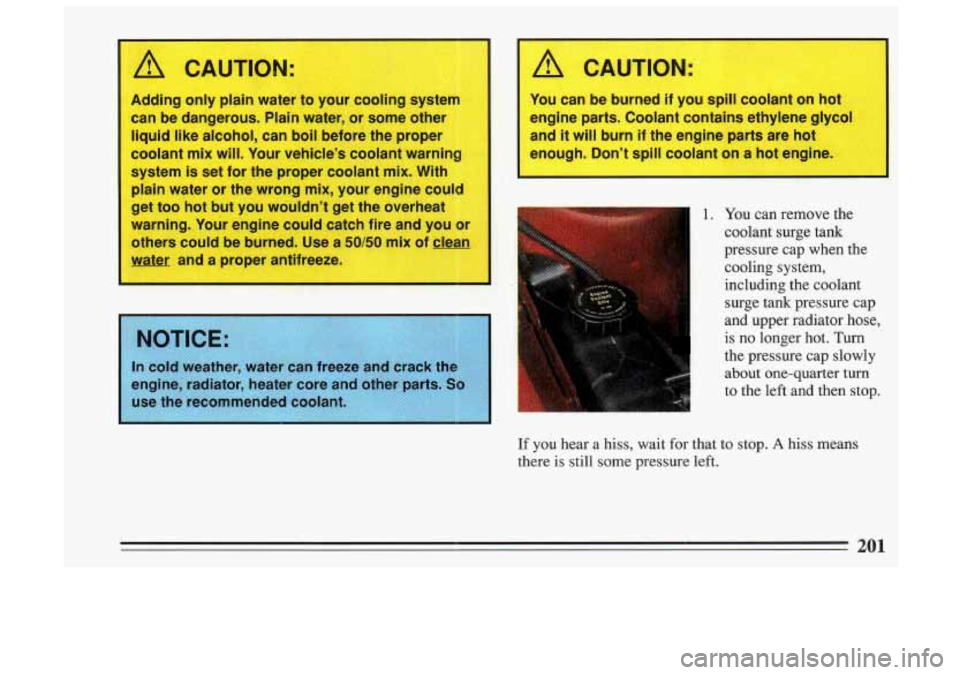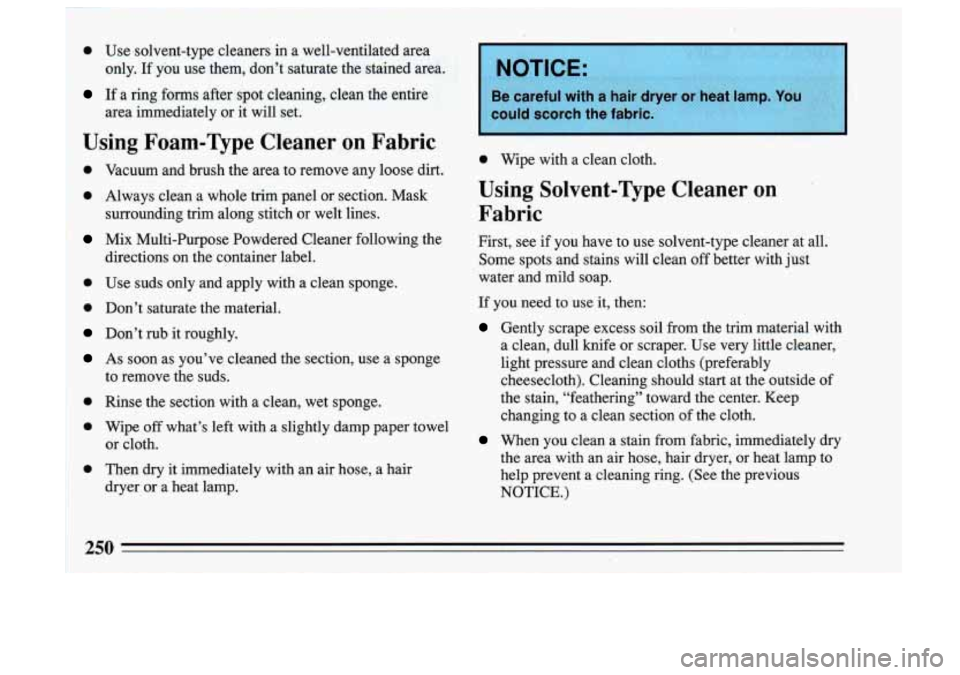1993 BUICK SKYLARK low oil pressure
[x] Cancel search: low oil pressurePage 116 of 306

This gage tells you if there could be a problem with your
engine oil pressure.
If the gage reads in the red band, and stays there, it
means oil isn’t going through your engine properly. You
could be low on oil or you might have some other oil
problem.
Don’t keep driving if the oil pressure is low. If
you do, your engine can become so hot that it
catches fire. You or others could be burned.
Check your oil as soon as possible and hp-
I your vehicle serviced.
“Check Oil” Light
e
The “Check Oil” light is lit
for three seconds as a bulb
check each time the
ignition key
is turned to the
RUN position. If the light
doesn’t come on, have your vehicle serviced.
If ‘the engine oil is more than one quart low, the light
will come on briefly, then
go off for 15 - 25 seconds,
and then come back on for
20 - 40 seconds.
However, under the following conditions, the system
will not register a low engine oil condition.
0 If the vehicle is tilted more than 20°. I problems can be costly and is not covered by
If it has not been more than 8 minutes since the
engine was last shut off.
115
Page 169 of 306

start bralung. If you must brake on the through lane, and
if there
is traffic close behind you, you can allow a little
extra time and flash your brake lights (in addition to your turn signal) as extra warning that you are about to
slow down and exit.
The exit ramp can be curved, sometimes quite sharply.
The exit speed is usually posted. Reduce your speed
according to your speedometer, not to your sense of
motion. After driving for any distance at higher speeds,
you may tend to think you are going slower than you
actually are. For example,
40 mph (65 km/h) might
seem like only
20 mph (30 km/h). Obviously, this could
lead to serious trouble on a ramp designed for
20 mph
(30 krn/h)!
Driving a Long Distance
Although most long trips today are made on freeways,
there are still many made on regular highways.
Long-distance driving on freeways and regular
highways is the same in some ways. The trip has to be
planned and the vehicle prepared, you drive at
higher-than-city speeds, and there are longer turns
behind the wheel. You’ll enjoy your trip more if you and
your vehicle are
in good shape. Here are some tips for a
successful long trip.
Before Leaving on a Long Trip
Make sure you’re ready. Try to be well rested. If you
must start when you’re not fresh
-- such as after a day’s
work
-- don’t plan to make too many miles that first part
of the journey. Wear comfortable clothing and shoes you
can easily drive in.
Is your vehicle ready for a long trip? If you keep it
serviced and maintained, it’s ready to go. If it needs
service, have it done before starting out. Of course,
you’ll find experienced and able service experts in
Buick dealerships all across North America. They’ll be
ready and willing to help
if you need it.
Here are some things you can check before a trip:
0 Windshield Washer Fluid: Is the reservoir full? Are
all windows clean inside and outside?
WiDer Blades: Are they in good shape/
Fuel, Engine Oil, Other Fluids: Have you checked
all levels?
0 Lights: Are they all working? Are the lenses clean?
0 Tires: They are vitally important to a safe,
trouble-free trip. Is the tread good enough for long-distance driving?
Are the tires all inflated to the
recommended pressure?
168
Page 202 of 306

1
A CAUTION':
Adding only plain water to your cooling system
can be dangerous. Plain water, or some lother
liquid li~ke alcohol, can boil before tihe proper
coolant
mix will. Your whicl'e's CoOilant warning
You can1 be burned if you spill coolant on hot ,,
engilne ~parts. Coolaint contains ethylene glycol
and lit wil~il burn if the enlgine parts are ,hot
enough. hn't spill coolant
on a hot engine. I
system is set for the proper coolant mix. With
plain water or the wron.g, mix, your engi'ne could8 1
get too h,ot but you wouldn't get thie overheat
warning. Your engine could catclh fire and
you or
others could
be burned. Use ;a 50/50 mix of clean
water and a proper antifreeze.
1
I
1-
1. You can remove the
coolant surge tank
pressure cap when the
cooling system,
including the coolant
surge
tank pressure cap
and upper radiator hose,
is no longer hot. Turn
the pressure cap slowly
i about one-quarter turn
1 to the left and then stop. I
If you hear a hiss, wait for that to stop. A hiss means
there is still some pressure left.
201
Page 251 of 306

r
1 e Use solvent-type cleaners in a well-ventilated area
only.
If you use them, don’t saturate the stained area.
If a ring forms after spot cleaning, clean the entire
area immediately or it will
set.
Using Foam-Type Cleaner on Fabric I
0 Vacuum and brush the area to remove any loose dirt.
0 Always clean a whole trim panel or section. Mask ’
surrounding trim along stitch or welt lines.
Mix Multi-Purpose Powdered Cleaner following the
directions on the container label.
0 Use suds only and apply with a clean sponge.
0 Don’t saturate the material.
Don’t rub it roughly.
As soon as you’ve cleaned the section, use a sponge
to remove the suds.
0 Rinse the section with a clean, wet sponge.
0 Wipe off what’s left with a slightly damp paper towel
or cloth.
0 Then dry it immediately with an air hose, a hair
dryer or a heat lamp.
1
0 Wipe *with a clean cloth.
Using Solvent-Type Cleaner on
Fabric
First, see if you have to use solvent-type cleaner at all.
Some spots and stains will clean
off better with just
water and mild soap.
If
you need to use it, then:
Gently scrape excess soil from the trim material with
a clean, dull knife or scraper. Use very little cleaner,
light pressure and clean cloths (preferably cheesecloth). Cleaning should start at the outside of
the stain, “feathering” toward the center. Keep
changing to a clean section of the cloth.
When you clean a stain from fabric, immediately dry
the area with an air hose, hair dryer, or heat lamp to
help prevent a cleaning ring. (See the previous
NOTICE.)
Page 299 of 306

Jacking up the Car ............................ .. 204
Jump Starting
................................... 188
Keys
........................................... 62
Keyless Entry System. Remote
...................... 67
Kilometer Indicator
.............................. 108 Label.
Service Parts Identification
.................. 257
Lane Change Indicator
............................. 89
LapBelt
........................................ 42
Lap-Shoulder Belt Usage by Children
................. 58
Latches. Front Seatback
............................ 19
Leaving Your Vehicle
.............................. 83
Light. Safety Belt ................................. 28
Light. Turn Signal Indicator
......................... 89
Light Bulbs. Replaceable
.......................... 262
Lighter. Cigarette
................................ 106
Lights Daytime Running
............................. 100
Interior
...................................... 99
Interior Delay
................................ 102
Operation
..................................... 99
Reading
..................................... 101
Traffic ...................................... 143
Lights “On” Warning
............................. 100
Loading Your Vehicle
............................ 240
Locks. Automatic Door
............................ 65
Locks. Door
..................................... 63
Locks. Rear Door Security
.......................... 69
Long Distance Driving
............................ 168
Loss of Control
................................. 158
Low Coolant Warning Light
....................... 113
Low Oil Pressure Warning Gage
.................... 114
298
Page 304 of 306

...... a . c
Underbody Maintenance ......................... 255
Uniform Tire Quality Grading
...................... 245
Unleaded Gasoline
............................... 2 17
Uphill Parking
.................................. 173
Upholstery Care
................................. 249
Used Oil. How to Dispose
of ....................... 227
Used Replacement Wheels
......................... 248
Vehicle Damage Warnings
......................... 11
Vehicle Identification Number ...................... 257
Vehicle Storage
................................. 237
Vehicle Symbols
.................................. 12
Volts Gage
..................................... 116
Vinyl. Cleaning
................................. 251
Visor Vanity Mirror
.............................. 104
warnings Devices
.............................. 187
Warning. Hazard Flasher
.......................... 186
Warning Lights
Antilock Brake System
......................... 11 1
Battery
....................................... 116
Brakesystem
................................ 110
CheckOil
................................... 115
Engine Coolant Temperature
.................... 112
Engine Oil Pressure
............................ 114
Indicators and Gages on Instrument Panel
.......... 109
LowCoolant
................................. 113
Malfunction Indicator (Service Engine Soon)
....... 11 3
I
Warnings. Safety ................................. 10
Washer. Windshield
............................... 92
Wear Indicators. Disc Brake
....................... 152
Weather Strips
.................................. 254
Weight.of a Trailer
............................... 180
Wheel Alignment
................................ 246
Wheel Covers Removal
........................... 206
Wheel Replacement
.............................. 247
White Sidewall Tire Cleaning
...................... 254
Why Wear Safety Belts?
........................... 23
Windows. Power
................................. 87
Windshield
Cleaning
.................................... 252
Washer
..... : ................................ 92
Washer Fluid
.............................. 92. 235
Wipers
................................... 9252 1.
Winter Driving
.................................. 175
Working on Your Car
............................. 216
Worn Tires
..................................... 244
Wrecker Towing
................... ............. 193
Washing Your Vehicle
............................ 253
WheelNutTorque
............................... 211
Your Driving and the Road
....................... 137
Your Own Signals
............................... 144
Your Vehicle and the Environment
.................. 267